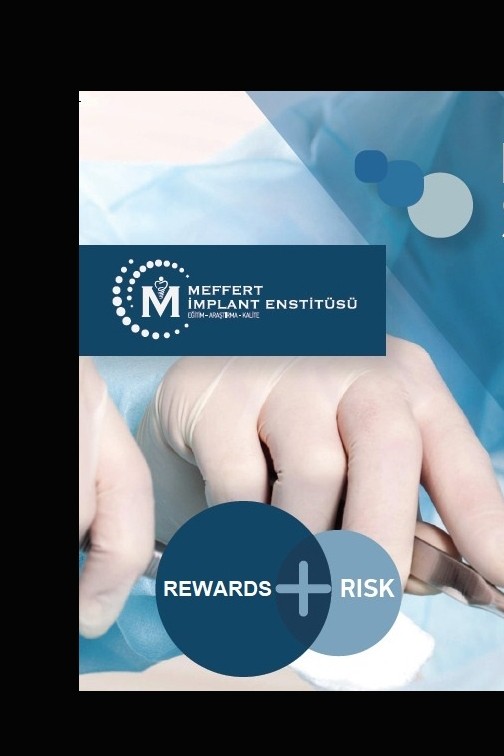Kısmı Dişsiz Üst Çenenin İmplant Destekli Sabit Protezlerle Rehabilitasyonu: Olgu Sunumu
Giriş: Kısmi diş eksikliği ve tam dişsiz hastaların tedavisinde dental implantlar uzun yıllardır yaygın şekilde kullanılmaktadır. İmplant destekli sabit protezler, dişsiz çenelerin tedavisinde uzun vadede yapılan klinik çalışmalarda estetik ve fonksiyonel olarak yüksek başarı oranlarıyla kabul görmüş ve gelişmeye devam eden bir tedavi yöntemidir. Günümüzde diş eksikliğinde ideal tedavi yaklaşımı dişsiz bölgelerin implant uygulanarak sabit restorasyonla tedavi edilmesidir. Bu olgu sunumunda üst çenesinde sadece iki adet ikinci büyük azı dişleri bulunan, alt çenesinde kendi dişleri mevcut olan hastanın rehabilitasyonu anlatılmaktadır.
Olgu: 30 yaşında bayan hasta diş eksikliği şikayeti ile kliniğimize başvurdu. Herhangi bir sistemik hastalığı bulunmayan hasta klinik ve radyografik olarak incelendi. Hastanın talepleri göz önünde bulundurularak hastaya implant destekli sabit protez yapılmasına karar verildi. Hastanın üst çenesine 6 adet implant yerleştirildi ve simante protez yapıldı. Alt çenesinde kesici dişlerini kaybeden hastaya kanin dişleri prepare edilerek simante protez uygulandı.
Tartışma ve Sonuç: Bu tedavi prosedürü ile hastanın estetik ve fonksiyonel beklentilerini karşılayan protetik tedavisi tamamlandı. Yapılan 1. ve 3. ay kontrollerinde herhangi bir biyolojik, biyomekanik, fonksiyonel ve estetik komplikasyonla karşılaşılmadı. Ancak plak birikimi nedeniyle ileride oluşabilecek komplikasyonlara karşı hasta biligilendirildi. Ağız bakımı konusunda tekrar motive edildi. Hasta estetik ve fonksiyonel sonuçlardan son derece memnun kaldı.
Anahtar Kelimeler:
Kısmı dişsiz üst çene, implant destekli sabit protezler, implant
Rehabilitation of The Partially Edentulous Maxilla with Implant-Supported Fixed Prostheses: A Case Report
Introduction: Dental implants have been widely used for many years in the treatment of partial tooth deficiency and edentulous patients. Dental implants have evolved into an established and routinely performed modality for the replacement of missing teeth, and the published results suggest an almost flawless outcome in terms of esthetics and function. Today, the ideal treatment approach in tooth deficiency is to treat edentulous areas with fixed restoration by applying implants. In this case report, the rehabilitation of a patient who has only two second molars in her upper jaw and her own teeth in her lower jaw is described.
Case: A 30-year-old female patient applied to our clinic with the complaint of missing teeth. The patient, who did not have any systemic disease, was examined clinically and radiographically. Considering the patients demands, it was decided to make an implant-supported fixed prosthesis for the patient. Six implants were placed in the maxilla of the patient and a cemented prosthesis was made. The canine teeth were prepared and a cemented prosthesis was applied to the patient who lost her incisors in her lower jaw.
Discussion & Conclusion: With this treatment procedure, the prosthetic treatment that meets the aesthetic and functional expectations of the patient was completed. No biological, biomechanical, functional and aesthetic complications were encountered in the 1. and 3. month controls. However, the patient was informed about future complications due to plaque accumulation. She was motivated again about oral care. The patient was extremely satisfied with the aesthetic and functional results.
___
- Journal of Meffert Implant Institute Implant Master Symposium
- Başlangıç: 2017
- Yayıncı: Meffert İmplant Enstitüsü
Sayıdaki Diğer Makaleler
Kısmı Dişsiz Üst Çenenin İmplant Destekli Sabit Protezlerle Rehabilitasyonu: Olgu Sunumu
Bahadır SANCAR, Ömer Faruk BOYLU, Özlem ELVERİŞLİ
Halil İbrahim AYGÜN, Duygu KILIÇ, Zekeriya TAŞDEMIR
Nagehan BAKİ, Mesut TUZLALI, Erkan BAHÇE, Esma Başak GÜL AYGÜN, Volkan ARISAN, Mutlu ÖZCAN
